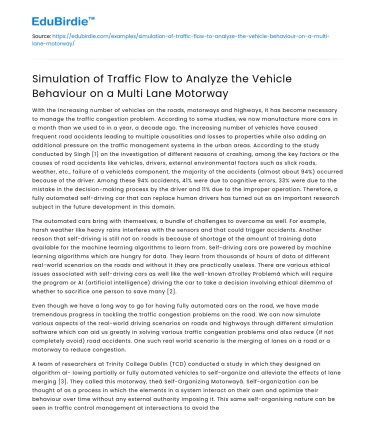With the increasing number of vehicles on the roads, motorways and highways, it has become necessary to manage the traffic congestion problem. According to some studies, we now manufacture more cars in a month than we used to in a year, a decade ago. The increasing number of vehicles have caused frequent road accidents leading to multiple causalities and losses to properties while also adding an additional pressure on the traffic management systems in the urban areas. According to the study conducted by Singh [1] on the investigation of different reasons of crashing, among the key factors or the causes of road accidents like vehicles, drivers, external environmental factors such as slick roads, weather, etc., failure of a vehicleâs component, the majority of the accidents (almost about 94%) occurred because of the driver. Among these 94% accidents, 41% were due to cognitive errors, 33% were due to the mistake in the decision-making process by the driver and 11% due to the improper operation. Therefore, a fully automated self-driving car that can replace human drivers has turned out as an important research subject in the future development in this domain.
The automated cars bring with themselves, a bundle of challenges to overcome as well. For example, harsh weather like heavy rains interferes with the sensors and that could trigger accidents. Another reason that self-driving is still not on roads is because of shortage of the amount of training data available for the machine learning algorithms to learn from. Self-driving cars are powered by machine learning algorithms which are hungry for data. They learn from thousands of hours of data of different real-world scenarios on the roads and without it they are practically useless. There are various ethical issues associated with self-driving cars as well like the well-known âTrolley Problemâ which will require the program or AI (artificial intelligence) driving the car to take a decision involving ethical dilemma of whether to sacrifice one person to save many [2].
Save your time!
We can take care of your essay
- Proper editing and formatting
- Free revision, title page, and bibliography
- Flexible prices and money-back guarantee
Even though we have a long way to go for having fully automated cars on the road, we have made tremendous progress in tackling the traffic congestion problems on the road. We can now simulate various aspects of the real-world driving scenarios on roads and highways through different simulation software which can aid us greatly in solving various traffic congestion problems and also reduce (if not completely avoid) road accidents. One such real world scenario is the merging of lanes on a road or a motorway to reduce congestion.
A team of researchers at Trinity College Dublin (TCD) conducted a study in which they designed an algorithm al- lowing partially or fully automated vehicles to self-organize and alleviate the effects of lane merging [3]. They called this motorway, theâ Self-Organizing Motorwayâ. Self-organization can be thought of as a process in which the elements in a system interact on their own and optimize their behaviour over time without any external authority imposing it. This same self-organising nature can be seen in traffic control management at intersections to avoid the traffic jam problems [4]. The simulation software used in the motorway study is called VISSIM. The team at trinity developed a multi-modal simulation of traffic flow in a scenario in which a three lane motorway merges into two lanes after a distance of 2km. The primary objective of this study is to replicate different aspects of the Self-organising Motorway research considering real world scenarios, using the discrete event simulation python package known as Simpy. This study will focus on creating separate models for simulating different scenarios in a two-lane motorway. These scenarios will also incorporate the erratic behaviour of the human drivers using different distributions for speeds and by also introducing the lane selection function which allows an entering vehicle to choose between the two lanes at random. But since we are considering a real-world scenario, we have given specific weights to each lane depending on the lane nature(slowfast). Different simulation models will be constructed for each of scenarios and the results (throughput, average travelling time, average speed and traffic density) are reported. These models will be discussed in the section IV. The results obtained and their interpretations will be summarized in section IV.
Did you like this example?
Make sure you submit a unique essay
Our writers will provide you with an essay sample written from scratch: any topic, any deadline, any instructions.
Cite this paper
-
APA
-
MLA
-
Harvard
-
Vancouver
Simulation of Traffic Flow to Analyze Vehicle Behavior on Motorways.
(2022, November 25). Edubirdie. Retrieved December 22, 2024, from https://edubirdie.com/examples/simulation-of-traffic-flow-to-analyze-the-vehicle-behaviour-on-a-multi-lane-motorway/
“Simulation of Traffic Flow to Analyze Vehicle Behavior on Motorways.” Edubirdie, 25 Nov. 2022, edubirdie.com/examples/simulation-of-traffic-flow-to-analyze-the-vehicle-behaviour-on-a-multi-lane-motorway/
Simulation of Traffic Flow to Analyze Vehicle Behavior on Motorways. [online].
Available at: <https://edubirdie.com/examples/simulation-of-traffic-flow-to-analyze-the-vehicle-behaviour-on-a-multi-lane-motorway/> [Accessed 22 Dec. 2024].
Simulation of Traffic Flow to Analyze Vehicle Behavior on Motorways [Internet]. Edubirdie.
2022 Nov 25 [cited 2024 Dec 22].
Available from: https://edubirdie.com/examples/simulation-of-traffic-flow-to-analyze-the-vehicle-behaviour-on-a-multi-lane-motorway/
copy






 Stuck on your essay?
Stuck on your essay?

